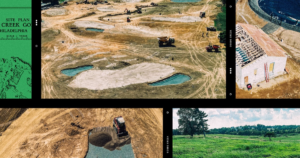At first glance, it doesn’t seem like the sort of place where you might come across extraordinary insights into the daily lives of the people who inhabited Bronze Age Britain.
But in the corner of a sports field Cardiffarchaeologists and volunteers discover a wealth of artifacts at the site of two roundhouses that provide clues about how people lived and worked there 3,500 years ago.
Last weekend, people cheered and clapped as the team unearthed a clay oven that a Bronze Age metalworker may have used to create weapons, tools and jewelery – believed to be only the second of its kind to be found in the UK and is considered a discovery of international importance.
A pot, possibly an urn, discovered later this week in the clay next to the kiln which may have contained the ashes of the prehistoric metal worker who used the kiln will also be excavated.
“It’s so exciting,” says Oliver Davis, Co-Director of the Caerau and Ely Rediscovery Heritage Project (CAER). “The scope and scale of this site continues to amaze us. We don’t have a king under a parking lot [a reference to the discovery of the burial place of Richard III in Leicester] but we have prehistory under our football fields.”
The site in Trelai Park, Ely, was discovered in 2022 in a geophysical survey carried out when a school planned to build artificial sports pitches in a corner of the fields.
They found evidence of what appeared to be a large round house – thought to be the oldest house in Cardiff – and careful excavation was started by CAER, a partnership between Cardiff University, the community development organization Action in Caerau and Ely, local schools, residents and heritage bodies.
Since then, they found that there were actually two roundhouses built on the site. The first was apparently taken down on purpose, presumably when the occupants died, and a new one was erected in its place.
Davis points out the position of the hearth in the center of the more recent house. “Three and a half thousand years ago you would have a hearth,” he says. “It would have been dark and smoky. We found a lot of pottery there, so we know this is where they cook, prepare and probably eat food.”
In another area, the team unearthed evidence of grain being prepared, in a third a number of flints, suggesting that this was where tools were made. The floors of the two houses are intact because the field has never been plowed. “This is the actual surface that people stepped on in the Bronze Age,” says Davis. “It’s incredibly rare. We get this kind of incredibly rich picture of how people lived three and a half thousand years ago.”
Davis believes the furnace predates the two roundhouses and the pot or urn may contain the ashes of a metalworking ancestor of the residents. He also thinks they may have found evidence of a log circle under the houses. “It could have been an important gathering place,” he says.
Ely made the news last year when a rioting occurred after two teenagers who were being followed by the police died.
Dave Wyatt, a reader in civic mission at Cardiff University, thinks an important part of the project is putting the community at the centre. “It creates new life opportunities for everyone and challenges many of the negative stories,” he says. When the Guardian visited on Monday, pupils from Herbert Thompson Primary School were being shown around.
Scott Bees, a former postal worker from Ely and now an archeology student, said, “The biggest thing I get out of it is finding out where we all came from, where this community came from.”
Volunteer Sian Davies, a retired care worker, found an arrowhead at the site last week: “To be given the chance to come down here and dig and delve into the history means an awful lot. It is a joy to find something like an arrowhead.”






